
Nurix Therapeutics Blazing a New Path in Medicine American Society of Hematology Investor Event December 9, 2024 Exhibit 99.2

2 Important Notice and Disclaimers This presentation contains statements that relate to future events and expectations and as such constitute forward-looking statements within the meaning of the Private Securities Litigation Reform Act of 1995. When or if used in this presentation, the words “anticipate,” “believe,” “could,” “estimate,” “expect,” “intend,” “may,” “outlook,” “plan,” “predict,” “should,” “will,” and similar expressions and their variants, as they relate to Nurix Therapeutics, Inc. (“Nurix”, the “Company,” “we,” “us” or “our”), may identify forward-looking statements. All statements that reflect Nurix’s expectations, assumptions or projections about the future, other than statements of historical fact, are forward-looking statements, including, without limitation, statements regarding our future financial or business plans; our future performance, prospects and strategies; future conditions, trends, and other financial and business matters; our current and prospective drug candidates; the planned timing and conduct of the clinical trial programs for our drug candidates; the planned timing for the provision of clinical updates and initial findings from our clinical studies; the potential benefits of our collaborations, including potential milestone and sales-related payments; the potential advantages of our DELigase platform and drug candidates; the extent to which our scientific approach, our DELigase platform, targeted protein modulation, and Degrader- Antibody Conjugates may potentially address a broad range of diseases; the extent animal model data predicts human efficacy; and the timing and success of the development and commercialization of our current and anticipated drug candidates. Forward-looking statements reflect Nurix’s current beliefs, expectations, and assumptions. Although Nurix believes the expectations and assumptions reflected in such forward-looking statements are reasonable, Nurix can give no assurance that they will prove to be correct. Forward-looking statements are not guarantees of future performance and are subject to risks, uncertainties and changes in circumstances that are difficult to predict, which could cause Nurix’s actual activities and results to differ materially from those expressed in any forward-looking statement. Such risks and uncertainties include, but are not limited to: (i) risks and uncertainties related to Nurix’s ability to advance its drug candidates, obtain regulatory approval of and ultimately commercialize its drug candidates; (ii) the timing and results of clinical trials; (iii) Nurix’s ability to fund development activities and achieve development goals; (iv) risks and uncertainties relating to the timing and receipt of payments from Nurix's collaboration partners, including milestone payments and royalties on future potential product sales; (v) the impact of macroeconomic events and conditions, including increasing financial market volatility and uncertainty, inflation, interest rate fluctuations, instability in the global banking system, uncertainty with respect to the federal budget and debt ceiling, the impact of war, military or regional conflicts, and global health pandemics, on Nurix’s clinical trials and operations; (vi) Nurix’s ability to protect intellectual property and (vii) other risks and uncertainties described under the heading “Risk Factors” in Nurix’s Quarterly Report on Form 10-Q for the fiscal quarter ended August 31, 2024, and other SEC filings. Accordingly, readers are cautioned not to place undue reliance on these forward-looking statements. The statements in this presentation speak only as of the date of this presentation, even if subsequently made available by Nurix on its website or otherwise. Nurix disclaims any intention or obligation to update publicly any forward-looking statements, whether in response to new information, future events, or otherwise, except as required by applicable law. Certain information contained in this presentation relates to or is based on studies, publications, surveys and other data obtained from third-party sources and the Company’s own internal estimates and research. While the Company believes these third-party sources to be reliable as of the date of this presentation, it has not independently verified, and makes no representation as to the adequacy, fairness, accuracy or completeness of, any information obtained from third-party sources. In addition, all of the market data included in this presentation involves a number of assumptions and limitations, and there can be no guarantee as to the accuracy or reliability of such assumptions. Finally, while we believe our own internal estimates and research are reliable, such estimates and research have not been verified by any independent source.
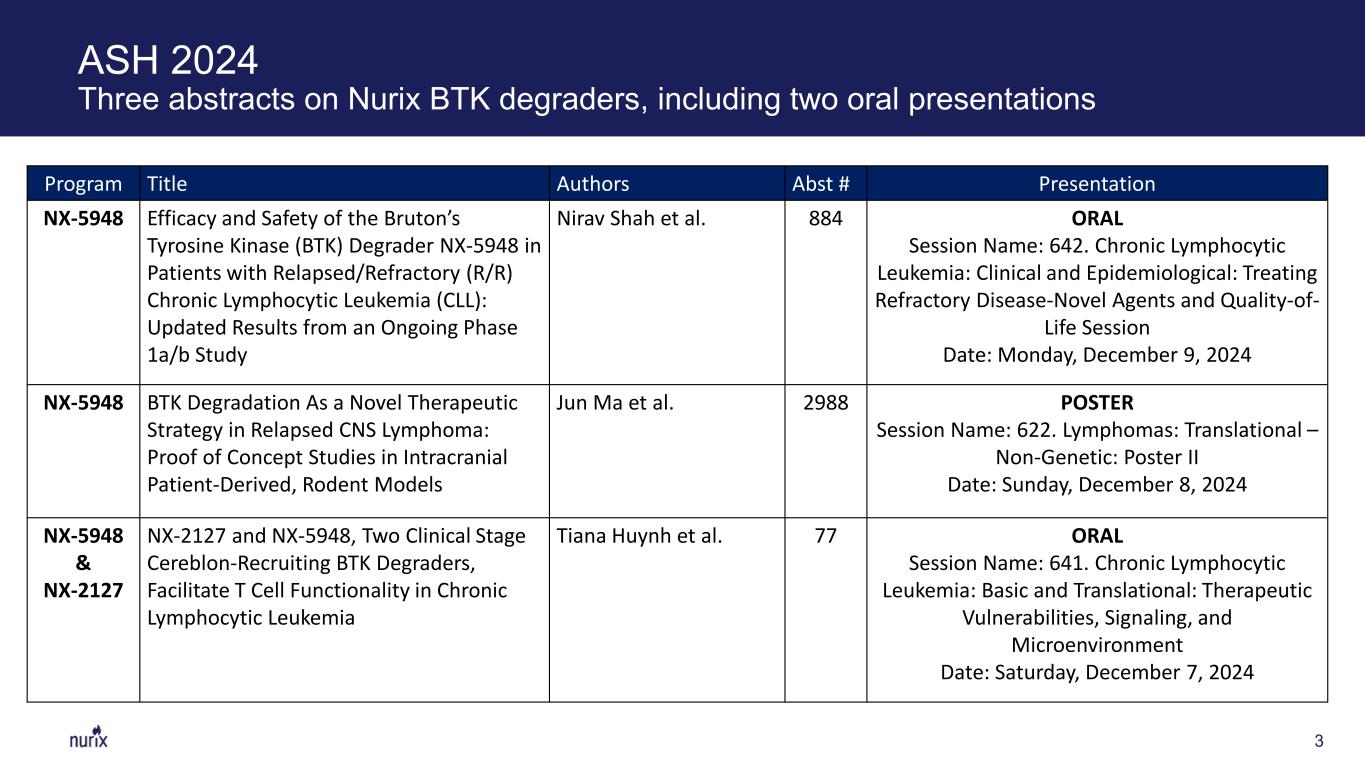
3 ASH 2024 Three abstracts on Nurix BTK degraders, including two oral presentations Program Title Authors Abst # Presentation NX-5948 Efficacy and Safety of the Bruton’s Tyrosine Kinase (BTK) Degrader NX-5948 in Patients with Relapsed/Refractory (R/R) Chronic Lymphocytic Leukemia (CLL): Updated Results from an Ongoing Phase 1a/b Study Nirav Shah et al. 884 ORAL Session Name: 642. Chronic Lymphocytic Leukemia: Clinical and Epidemiological: Treating Refractory Disease-Novel Agents and Quality-of- Life Session Date: Monday, December 9, 2024 NX-5948 BTK Degradation As a Novel Therapeutic Strategy in Relapsed CNS Lymphoma: Proof of Concept Studies in Intracranial Patient-Derived, Rodent Models Jun Ma et al. 2988 POSTER Session Name: 622. Lymphomas: Translational – Non-Genetic: Poster II Date: Sunday, December 8, 2024 NX-5948 & NX-2127 NX-2127 and NX-5948, Two Clinical Stage Cereblon-Recruiting BTK Degraders, Facilitate T Cell Functionality in Chronic Lymphocytic Leukemia Tiana Huynh et al. 77 ORAL Session Name: 641. Chronic Lymphocytic Leukemia: Basic and Translational: Therapeutic Vulnerabilities, Signaling, and Microenvironment Date: Saturday, December 7, 2024

NX-5948: Efficacy and safety of NX-5948 in patients with relapsed/refractory chronic lymphocytic leukemia NX-5948: Preliminary findings in patients with Waldenstrom’s Macroglobulinemia Nirav N. Shah, M.D., MSHP Associate Professor of Medicine, Division of Hematology and Oncology, Medical College of Wisconsin NX-5948: Advancing into pivotal development in 2025 Paula G. O’Connor, M.D. Chief Medical Officer, Nurix Therapeutics Section I: Q&A NX-2127 and NX-1607: Clinical updates and next steps Paula G. O’Connor, M.D. Chief Medical Officer, Nurix Therapeutics Rationale for assessing NX-5948 in inflammation and immunology (I&I) Gwenn M. Hansen, Ph.D. Chief Scientific Officer, Nurix Therapeutics Nurix’s I&I strategy Arthur T. Sands, M.D., Ph.D. Chief Executive Officer, Nurix Therapeutics Section II: Q&A Agenda 4

Efficacy and safety of the Bruton’s tyrosine kinase (BTK) degrader NX-5948 in patients with relapsed/refractory chronic lymphocytic leukemia: updated results from an ongoing Phase 1a/b study Nirav N. Shah, Zulfa Omer, Graham Collins, Francesco Forconi, Alexey Danilov, John C. Byrd, Dima El Sharkawi, Emma Searle, Alvaro Alencar, Shuo Ma, Sarah Injac, Talha Munir ASH 2024 Annual Meeting, San Diego CA – December 9, 2024
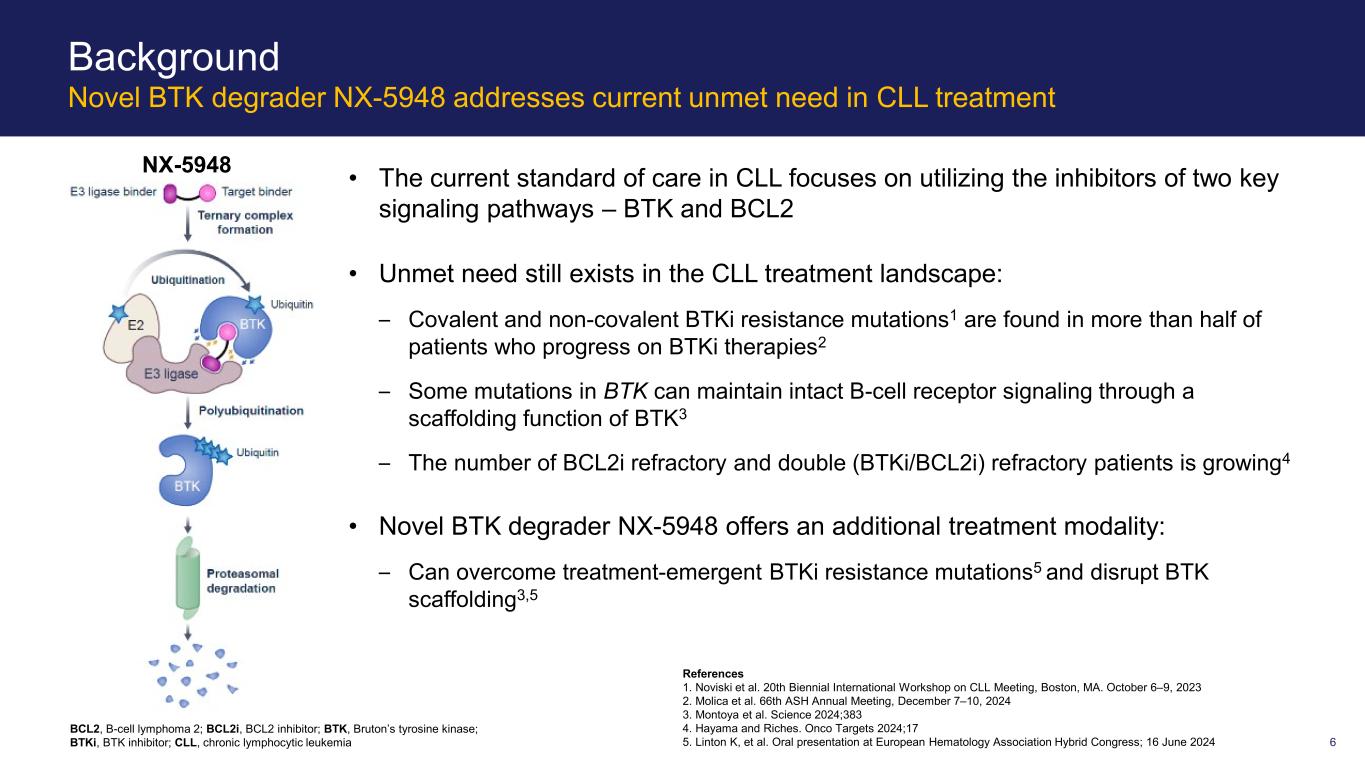
• The current standard of care in CLL focuses on utilizing the inhibitors of two key signaling pathways – BTK and BCL2 • Unmet need still exists in the CLL treatment landscape: – Covalent and non-covalent BTKi resistance mutations1 are found in more than half of patients who progress on BTKi therapies2 – Some mutations in BTK can maintain intact B-cell receptor signaling through a scaffolding function of BTK3 – The number of BCL2i refractory and double (BTKi/BCL2i) refractory patients is growing4 • Novel BTK degrader NX-5948 offers an additional treatment modality: – Can overcome treatment-emergent BTKi resistance mutations5 and disrupt BTK scaffolding3,5 6 Background Novel BTK degrader NX-5948 addresses current unmet need in CLL treatment References 1. Noviski et al. 20th Biennial International Workshop on CLL Meeting, Boston, MA. October 6–9, 2023 2. Molica et al. 66th ASH Annual Meeting, December 7–10, 2024 3. Montoya et al. Science 2024;383 4. Hayama and Riches. Onco Targets 2024;17 5. Linton K, et al. Oral presentation at European Hematology Association Hybrid Congress; 16 June 2024 NX-5948 BCL2, B-cell lymphoma 2; BCL2i, BCL2 inhibitor; BTK, Bruton’s tyrosine kinase; BTKi, BTK inhibitor; CLL, chronic lymphocytic leukemia
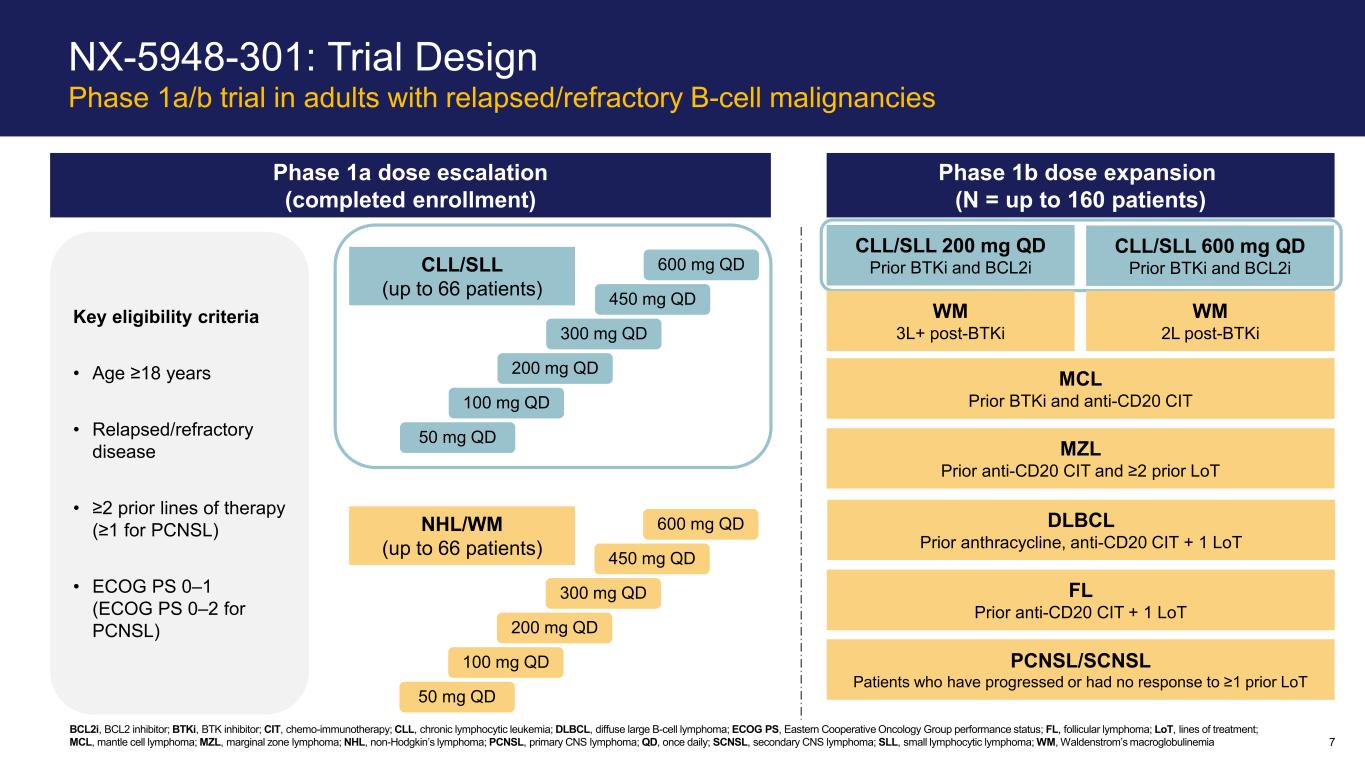
Phase 1a dose escalation (completed enrollment) Phase 1b dose expansion (N = up to 160 patients) Key eligibility criteria • Age ≥18 years • Relapsed/refractory disease • ≥2 prior lines of therapy (≥1 for PCNSL) • ECOG PS 0–1 (ECOG PS 0–2 for PCNSL) 50 mg QD 100 mg QD 200 mg QD 300 mg QD 450 mg QD 600 mg QDNHL/WM (up to 66 patients) CLL/SLL 200 mg QD Prior BTKi and BCL2i MCL Prior BTKi and anti-CD20 CIT PCNSL/SCNSL Patients who have progressed or had no response to ≥1 prior LoT DLBCL Prior anthracycline, anti-CD20 CIT + 1 LoT MZL Prior anti-CD20 CIT and ≥2 prior LoT FL Prior anti-CD20 CIT + 1 LoT CLL/SLL 600 mg QD Prior BTKi and BCL2iCLL/SLL (up to 66 patients) 50 mg QD 100 mg QD 200 mg QD 300 mg QD 450 mg QD 600 mg QD 7 NX-5948-301: Trial Design Phase 1a/b trial in adults with relapsed/refractory B-cell malignancies BCL2i, BCL2 inhibitor; BTKi, BTK inhibitor; CIT, chemo-immunotherapy; CLL, chronic lymphocytic leukemia; DLBCL, diffuse large B-cell lymphoma; ECOG PS, Eastern Cooperative Oncology Group performance status; FL, follicular lymphoma; LoT, lines of treatment; MCL, mantle cell lymphoma; MZL, marginal zone lymphoma; NHL, non-Hodgkin’s lymphoma; PCNSL, primary CNS lymphoma; QD, once daily; SCNSL, secondary CNS lymphoma; SLL, small lymphocytic lymphoma; WM, Waldenstrom’s macroglobulinemia WM 3L+ post-BTKi WM 2L post-BTKi

8 CLL Patient Disposition and Demographics Phase 1a and 1b CLL, chronic lymphocytic leukemia; SLL, small lymphocytic lymphoma Dosed (n=60) 50 mg: n=3 100 mg: n=5 200 mg: n=14 300 mg: n=8 450 mg: n=7 600 mg: n=23 CLL/SLL (n=60) Discontinued treatment (n=14) Radiological progression: n=5 Clinical progression: n=4 Death: n=2 Physician decision: n=2 Adverse event: n=1 On treatment (n=46) Patient disposition Characteristics Patientsa (n=60) Median age, years (range) 67.0 (35–88) Sex, n (%) Male 38 (63.3) Ethnicity, n (%) Hispanic or Latino 4 (6.7) Race, n (%) Black or African American White Other 5 (8.3) 51 (85.0) 4 (6.7) Patient demographics aPopulation demographics in CLL cohort were comparable to those in the overall population Data cutoff: 10 Oct 2024
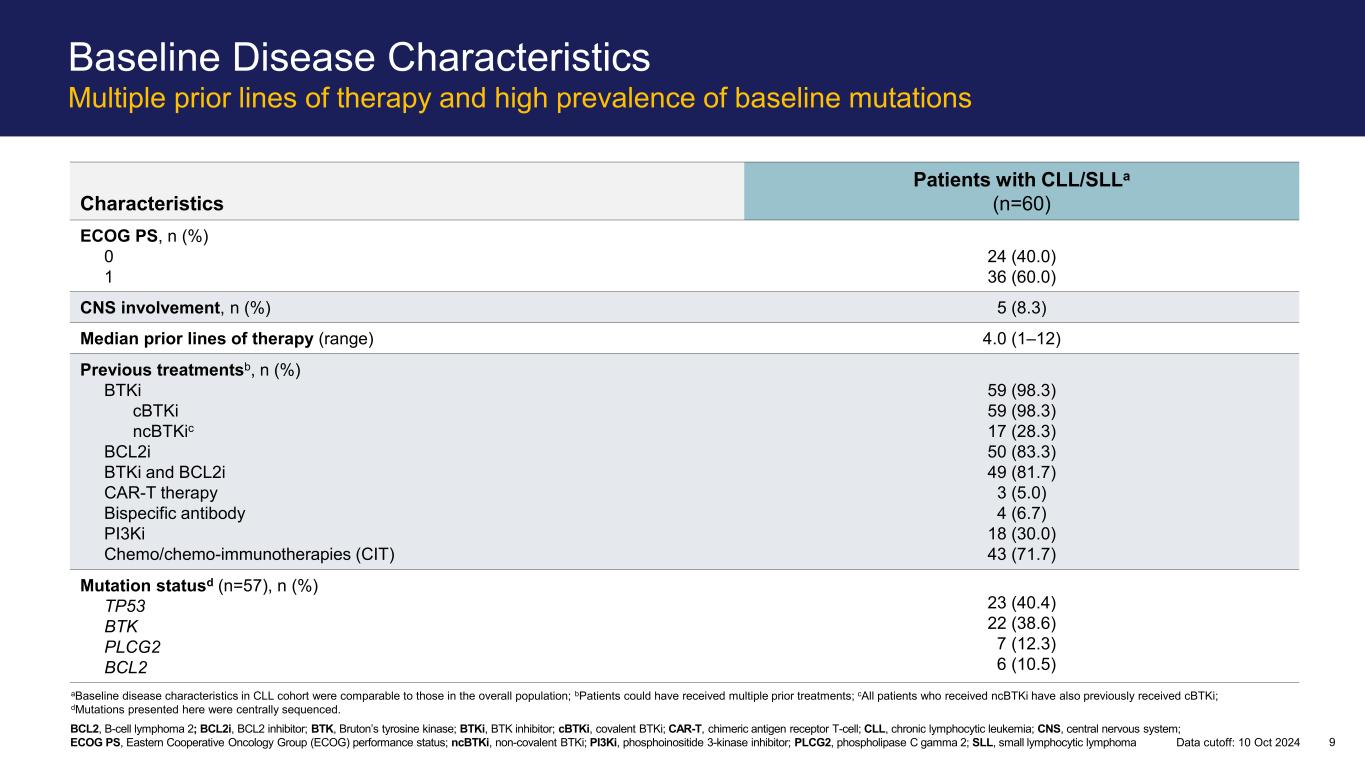
9 Baseline Disease Characteristics Multiple prior lines of therapy and high prevalence of baseline mutations Characteristics Patients with CLL/SLLa (n=60) ECOG PS, n (%) 0 1 24 (40.0) 36 (60.0) CNS involvement, n (%) 5 (8.3) Median prior lines of therapy (range) 4.0 (1–12) Previous treatmentsb, n (%) BTKi cBTKi ncBTKic BCL2i BTKi and BCL2i CAR-T therapy Bispecific antibody PI3Ki Chemo/chemo-immunotherapies (CIT) 59 (98.3) 59 (98.3) 17 (28.3) 50 (83.3) 49 (81.7) 3 (5.0) 4 (6.7) 18 (30.0) 43 (71.7) Mutation statusd (n=57), n (%) TP53 BTK PLCG2 BCL2 23 (40.4) 22 (38.6) 7 (12.3) 6 (10.5) aBaseline disease characteristics in CLL cohort were comparable to those in the overall population; bPatients could have received multiple prior treatments; cAll patients who received ncBTKi have also previously received cBTKi; dMutations presented here were centrally sequenced. BCL2, B-cell lymphoma 2; BCL2i, BCL2 inhibitor; BTK, Bruton’s tyrosine kinase; BTKi, BTK inhibitor; cBTKi, covalent BTKi; CAR-T, chimeric antigen receptor T-cell; CLL, chronic lymphocytic leukemia; CNS, central nervous system; ECOG PS, Eastern Cooperative Oncology Group (ECOG) performance status; ncBTKi, non-covalent BTKi; PI3Ki, phosphoinositide 3-kinase inhibitor; PLCG2, phospholipase C gamma 2; SLL, small lymphocytic lymphoma Data cutoff: 10 Oct 2024

10 NX-5948 Safety Profile TEAEs in ≥10% of overall population or Grade ≥3 TEAEs or SAEs in >1 patient aPurpura/contusion includes episodes of contusion or purpura; bFatigue was transient; cAggregate of ‘thrombocytopenia’ and ‘platelet count decreased’; dAggregate of ‘rash’ and ‘rash maculopapular’ and ‘rash pustular’; eAggregate of 'neutrophil count decreased' or 'neutropenia’; fAggregate of 'COVID-19' and 'COVID-19 pneumonia’; gAggregate of 'pneumonia’ and ‘pneumonia klebsiella' AE, adverse event; AFib, atrial fibrillation; CLL, chronic lymphocytic leukemia; NHL, non-Hodgkin’s lymphoma; SAE, serious adverse event; SLL, small lymphocytic lymphoma; TEAE, treatment emergent AE TEAEs, n (%) Patients with CLL/SLL (n=60) Overall population (N=125) Any grade Grade ≥3 SAEs Any grade Grade ≥3 SAEs Purpura/contusiona 22 (36.7) – – 42 (33.6) – – Fatigueb 16 (26.7) – – 29 (23.2) 2 (1.6) – Petechiae 16 (26.7) – – 28 (22.4) – – Thrombocytopeniac 10 (16.7) 1 (1.7) – 26 (20.8) 7 (5.6) – Rashd 14 (23.3) 1 (1.7) 1 (1.7) 24 (19.2) 2 (1.6) 1 (0.8) Neutropeniae 14 (23.3) 11 (18.3) – 23 (18.4) 18 (14.4) – Anemia 11 (18.3) 4 (6.7) – 21 (16.8) 10 (8.0) – Headache 10 (16.7) – – 21 (16.8) 1 (0.8) 1 (0.8) COVID-19f 10 (16.7) – – 19 (15.2) 2 (1.6) 2 (1.6) Diarrhea 12 (20.0) 1 (1.7) – 18 (14.4) 1 (0.8) – Cough 9 (15.0) – – 16 (12.8) 1 (0.8) – Pneumoniag 4 (6.7) 2 (3.3) 2 (3.3) 10 (8.0) 6 (4.8) 6 (4.8) Lower respiratory tract infection 3 (5.0) 1 (1.7) 1 (1.7) 9 (7.2) 3 (2.4) 2 (1.6) Fall 1 (1.7) 1 (1.7) 1 (1.7) 8 (6.4) 2 (1.6) 2 (1.6) Hypertension 2 (3.3) 1 (1.7) – 7 (5.6) 5 (4.0) – Hyponatremia – – – 3 (2.4) 2 (1.6) – Pulmonary embolism 1 (1.7) 1 (1.7) 1 (1.7) 2 (1.6) 2 (1.6) 2 (1.6) Subdural hematoma 1 (1.7) – 1 (1.7) 2 (1.6) 1 (0.8) 2 (1.6) • Tolerable safety profile consistent with prior disclosures • 1 case of Grade 1 AFib in a CLL patient with pre-existing AFib • 6 TEAEs resulted in drug discontinuation (1 CLL; 5 NHL) • 2 Grade 5 AEs (1 pulmonary embolism; 1 case pending) deemed not related to NX-5948 Data cutoff: 10 Oct 2024
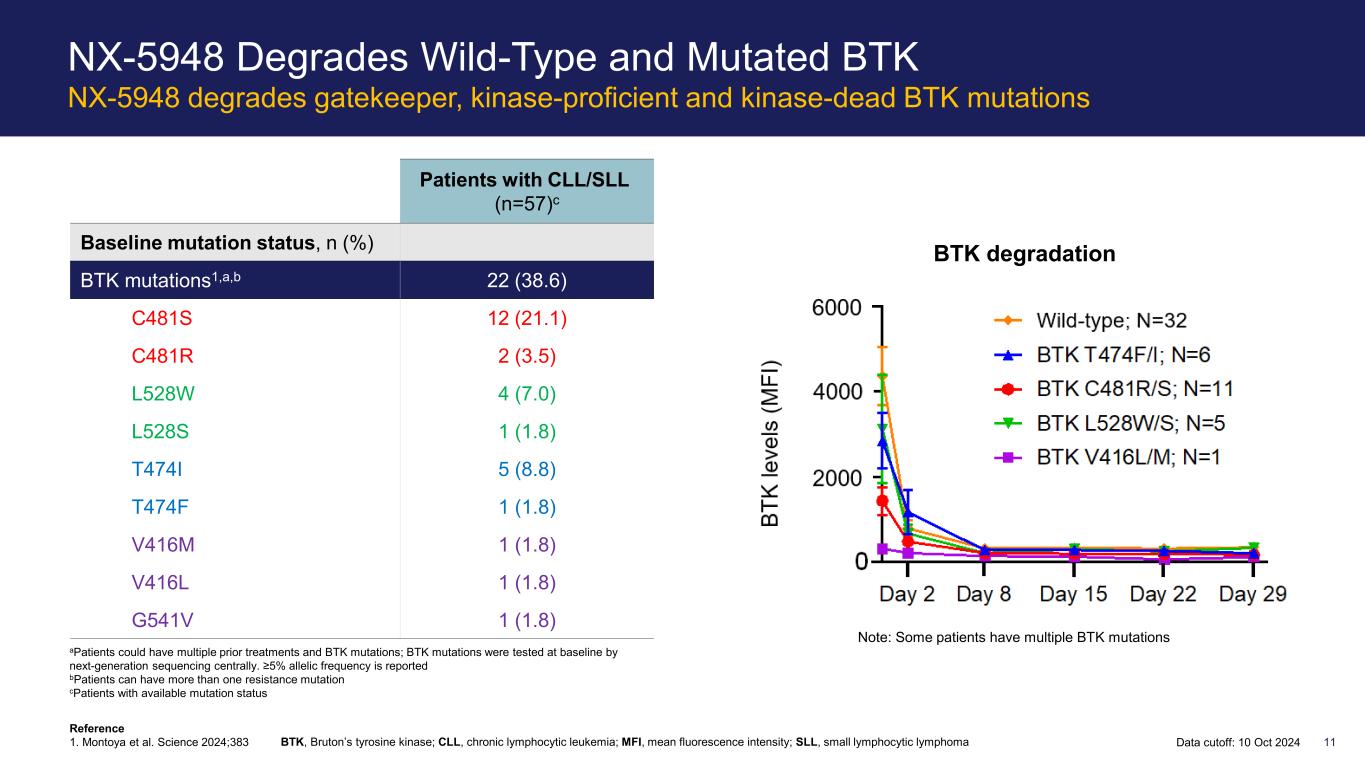
11 NX-5948 Degrades Wild-Type and Mutated BTK NX-5948 degrades gatekeeper, kinase-proficient and kinase-dead BTK mutations Patients with CLL/SLL (n=57)c Baseline mutation status, n (%) BTK mutations1,a,b 22 (38.6) C481S 12 (21.1) C481R 2 (3.5) L528W 4 (7.0) L528S 1 (1.8) T474I 5 (8.8) T474F 1 (1.8) V416M 1 (1.8) V416L 1 (1.8) G541V 1 (1.8) aPatients could have multiple prior treatments and BTK mutations; BTK mutations were tested at baseline by next-generation sequencing centrally. ≥5% allelic frequency is reported bPatients can have more than one resistance mutation cPatients with available mutation status BTK, Bruton’s tyrosine kinase; CLL, chronic lymphocytic leukemia; MFI, mean fluorescence intensity; SLL, small lymphocytic lymphoma Note: Some patients have multiple BTK mutations Reference 1. Montoya et al. Science 2024;383 Data cutoff: 10 Oct 2024 BTK degradation
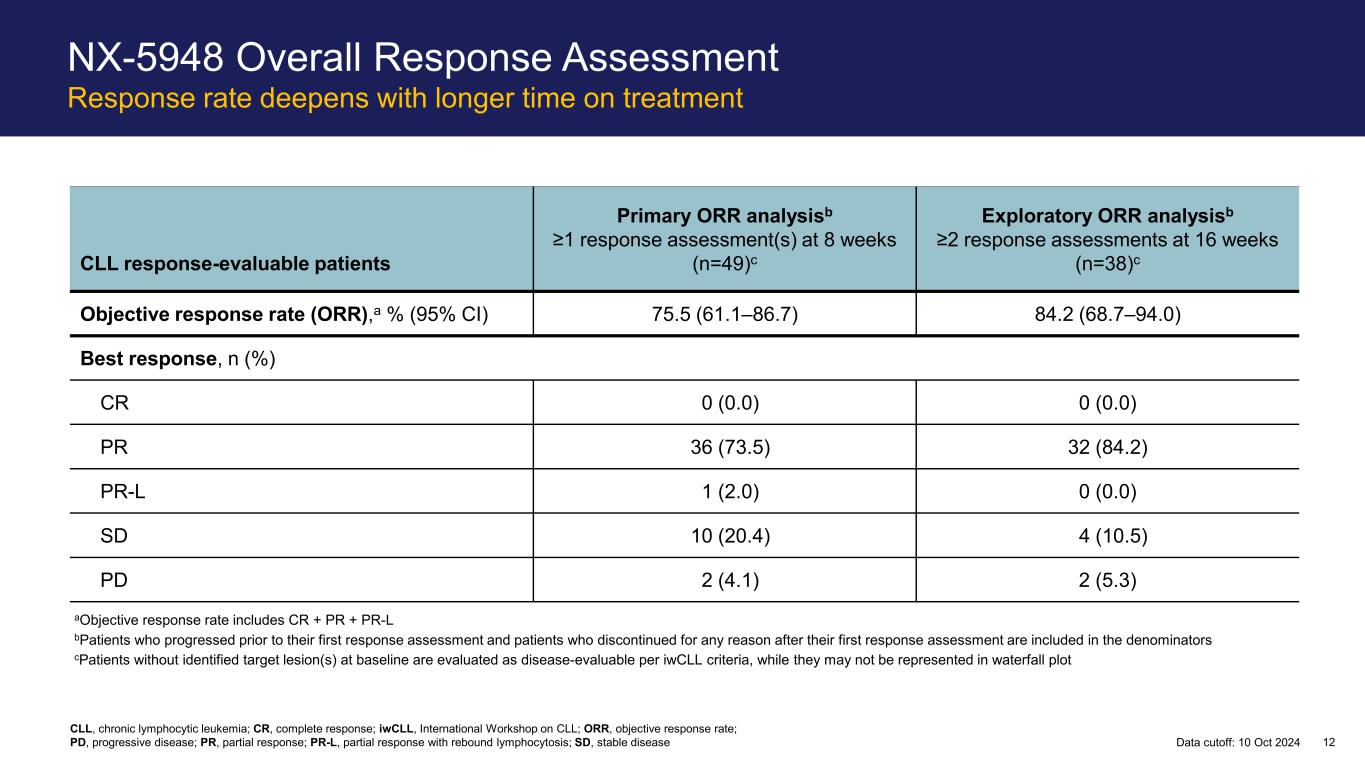
NX-5948 Overall Response Assessment Response rate deepens with longer time on treatment CLL response-evaluable patients Primary ORR analysisb ≥1 response assessment(s) at 8 weeks (n=49)c Exploratory ORR analysisb ≥2 response assessments at 16 weeks (n=38)c Objective response rate (ORR),a % (95% CI) 75.5 (61.1–86.7) 84.2 (68.7–94.0) Best response, n (%) CR 0 (0.0) 0 (0.0) PR 36 (73.5) 32 (84.2) PR-L 1 (2.0) 0 (0.0) SD 10 (20.4) 4 (10.5) PD 2 (4.1) 2 (5.3) aObjective response rate includes CR + PR + PR-L bPatients who progressed prior to their first response assessment and patients who discontinued for any reason after their first response assessment are included in the denominators cPatients without identified target lesion(s) at baseline are evaluated as disease-evaluable per iwCLL criteria, while they may not be represented in waterfall plot 12Data cutoff: 10 Oct 2024 CLL, chronic lymphocytic leukemia; CR, complete response; iwCLL, International Workshop on CLL; ORR, objective response rate; PD, progressive disease; PR, partial response; PR-L, partial response with rebound lymphocytosis; SD, stable disease

*Patient with Richter’s transformation to Hodgkin's on biopsy Note: patients without identified target lesion(s) at baseline are evaluated as disease-evaluable per iwCLL criteria, while they may not be represented in waterfall plot ATM, Ataxia-telangiectasia mutated; BTK, Bruton’s tyrosine kinase; BTKi, BTK inhibitor; CLL, chronic lymphocytic leukemia; CNS, central nervous system; iwCLL, International Workshop on CLL; NOTCH1, neurologic locus notch homolog protein 1; PLCG2, phospholipase C gamma 2; SPD, sum of products diameters Lymph Node Assessment and High-Risk Molecular Features Clinical activity in patients with CLL including those with baseline mutations and CNS involvement C ha ng e in ly m ph n od e si ze % c ha ng e fro m b as el in e in SP D o f t ar ge t l es io n( s) Patients with CNS involvement at baseline Dashed line indicates iwCLL response criteria threshold (50%) 13Data cutoff: 10 Oct 2024

14 NX-5948 Duration of Treatment Durable responses regardless of prior therapy BCL2i, BCL2 inhibitor; BTKi, BTK inhibitor; cBTKi, covalent BTKi; CIT, chemo/chemo-immunotherapies; ncBTKi, non-covalent BTKi; PD, progressive disease; PR, partial response; PR-L, PR with rebound lymphocytosis; SD, stable disease; CI, confidence interval *Patient with Richter’s transformation to Hodgkin's on biopsy Median duration of treatment, months (range) 3.9 (0.1–21.0) Patients dose escalated during treatment, n 19 Median duration of response, months (95% CI) Not reached (6.9 – not reached) Patients with duration of response >6 months 13 (26.5%) Data cutoff: 10 Oct 2024

• In this ongoing Phase 1 study, the BTK degrader NX-5948 demonstrated an encouraging clinical profile in a heavily pre-treated population of patients with CLL • NX-5948 was well tolerated across B-cell malignancies, with no additional safety signals observed with longer duration on study or increased dose • Robust and deepening clinical responses were observed in a heavily pretreated CLL patient population including patients with baseline BTK and PLCG2 mutations, high risk molecular features and CNS involvement – 75.5% ORR deepening to 84.2% ORR in patients with longer follow-up • Durable responses achieved in patients with high unmet clinical need, post-BTKi, BCL2i – 13 patients with duration of response 6+ months and 5 patients remaining on treatment beyond 1 year Phase 1b dose expansion is underway and pivotal trial(s) initiation is planned in 2025 Conclusions 15

NX-5948: Preliminary findings in patients with Waldenstrom’s macroglobulinemia 16 Highlights from the International Workshop on Waldenstrom's Macroglobulinemia (IWWM) in October 2024
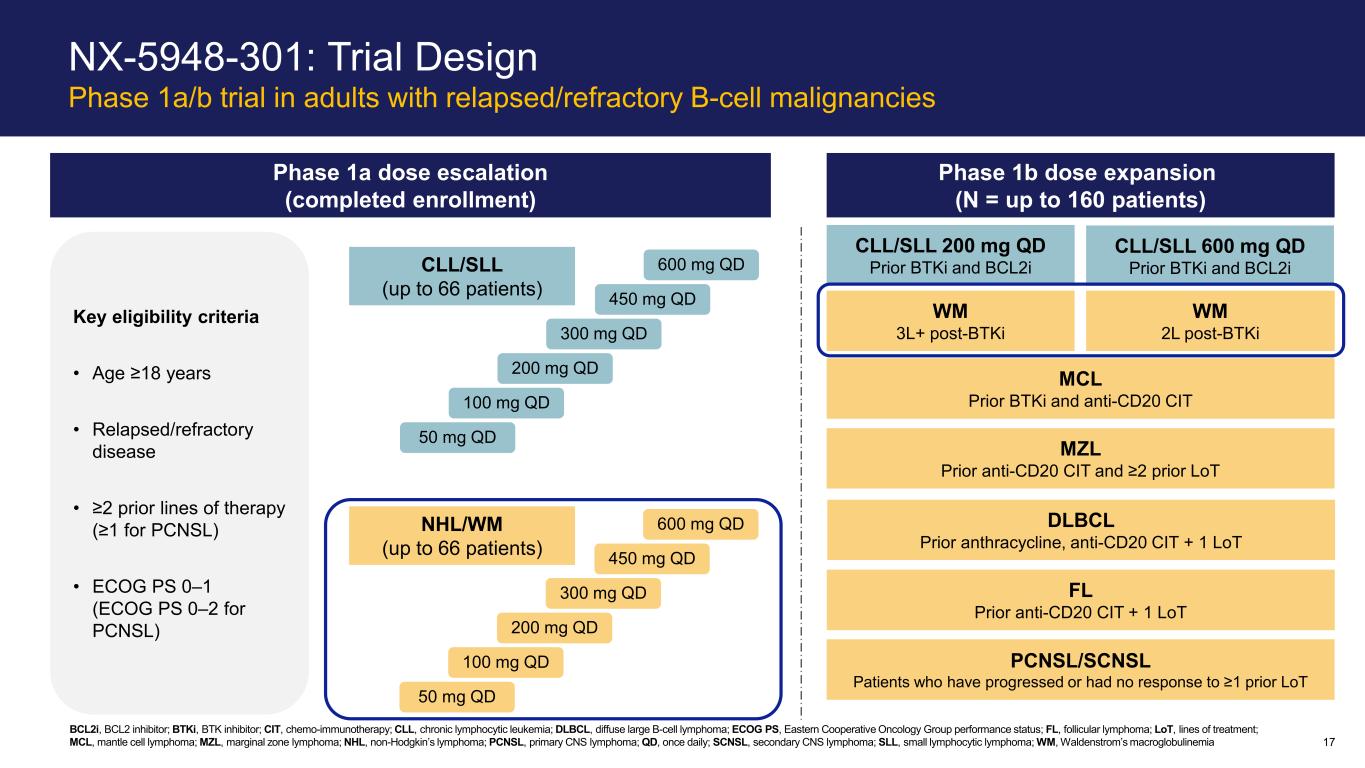
Phase 1a dose escalation (completed enrollment) Phase 1b dose expansion (N = up to 160 patients) Key eligibility criteria • Age ≥18 years • Relapsed/refractory disease • ≥2 prior lines of therapy (≥1 for PCNSL) • ECOG PS 0–1 (ECOG PS 0–2 for PCNSL) 50 mg QD 100 mg QD 200 mg QD 300 mg QD 450 mg QD 600 mg QDNHL/WM (up to 66 patients) CLL/SLL 200 mg QD Prior BTKi and BCL2i MCL Prior BTKi and anti-CD20 CIT PCNSL/SCNSL Patients who have progressed or had no response to ≥1 prior LoT DLBCL Prior anthracycline, anti-CD20 CIT + 1 LoT MZL Prior anti-CD20 CIT and ≥2 prior LoT FL Prior anti-CD20 CIT + 1 LoT CLL/SLL 600 mg QD Prior BTKi and BCL2iCLL/SLL (up to 66 patients) 50 mg QD 100 mg QD 200 mg QD 300 mg QD 450 mg QD 600 mg QD 17 NX-5948-301: Trial Design Phase 1a/b trial in adults with relapsed/refractory B-cell malignancies BCL2i, BCL2 inhibitor; BTKi, BTK inhibitor; CIT, chemo-immunotherapy; CLL, chronic lymphocytic leukemia; DLBCL, diffuse large B-cell lymphoma; ECOG PS, Eastern Cooperative Oncology Group performance status; FL, follicular lymphoma; LoT, lines of treatment; MCL, mantle cell lymphoma; MZL, marginal zone lymphoma; NHL, non-Hodgkin’s lymphoma; PCNSL, primary CNS lymphoma; QD, once daily; SCNSL, secondary CNS lymphoma; SLL, small lymphocytic lymphoma; WM, Waldenstrom’s macroglobulinemia WM 3L+ post-BTKi WM 2L post-BTKi

Baseline Demographics/Disease Characteristics Elderly population with multiple prior lines of targeted therapies Characteristics Patients with WM (n=13) Median age, years (range) 74.0 (64–82) Male, n (%) 11 (84.6) ECOG PS, n (%) 0 1 3 (23.1) 10 (76.9) CNS involvement, n (%) 0 Median prior lines of therapy (range) 3.0 (2–5) Previous treatmentsa, n (%) BTKi Pirtobrutinib BCL2i BTKi and BCL2i CAR-T therapy Bispecific antibody PI3Ki Chemo/chemo-immunotherapies 13 (100.0) 3 (23.1) 1 (7.7) 1 (7.7) 0 (0.0) 0 (0.0) 0 (0.0) 13 (100.0) Mutation status*, n (%) MYD88 CXCR4 (n=13) 8 (61.5) 2 (15.4) aPatients could have received multiple prior treatments *Mutation status was gathered from historic patient records Data cutoff: 10 Oct 2024BTKi, Bruton’s tyrosine kinase inhibitor; BCL2i, B-cell lymphoma 2 inhibitor; CAR-T, chimeric antigen receptor T-cell; CNS, central nervous system; ECOG PS, Eastern Cooperative Oncology Group (ECOG) performance status; PI3Ki, PI3 kinase inhibitor; WM, Waldenstrom’s macroglobulinemia 18

NX-5948 Efficacy and Duration of Treatment in Patients with WM Data cutoff: 10 Oct 2024 Select prior therapies Select mutations BTKi BCL2i Pirto CXCR4 MYD88 WM disease-evaluable patients n=9 ORR, % 77.8 Best response, n (%) CR 0 (0.0) PR / MR 7 (77.8) SD 2 (22.2) PD 0 (0.0) *Ineligible, identified post 1st dose #Transformed to DLBCL * # 19

Steady Decrease in IgM Levels in Patients Treated with NX-5948 Percent change in IgM levels from baseline in patients with WM1 Data cutoff: 10 Oct 2024 #Transformed to DLBCL 1Response criteria used: Owen RG, Kyle RA, Stone MJ, et al. VIth International Workshop on Waldenström macroglobulinaemia. Response assessment in Waldenström macroglobulinaemia: update from the VIth International Workshop. Br J Haematol 2013;160:171–6 # % c ha ng e fro m b as el in e in Ig M le ve l 20
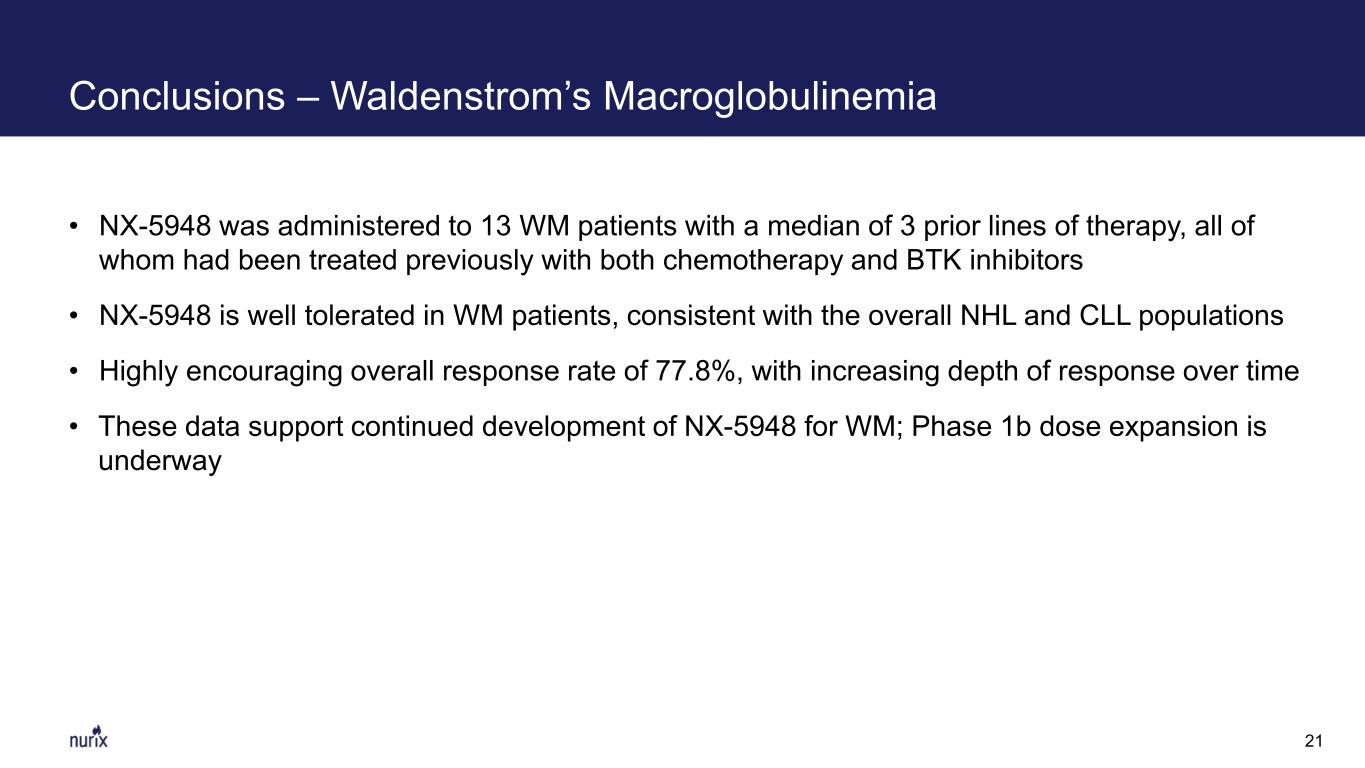
• NX-5948 was administered to 13 WM patients with a median of 3 prior lines of therapy, all of whom had been treated previously with both chemotherapy and BTK inhibitors • NX-5948 is well tolerated in WM patients, consistent with the overall NHL and CLL populations • Highly encouraging overall response rate of 77.8%, with increasing depth of response over time • These data support continued development of NX-5948 for WM; Phase 1b dose expansion is underway Conclusions – Waldenstrom’s Macroglobulinemia 21

NX-5948: Advancing into pivotal development in 2025 22 Regulatory update and development plans in CLL

• U.S. Fast Track Designation from the FDA in January 2024 • CLL Type B End of Phase 1 meeting held with the FDA, key takeaways: • Reviewed dose levels of 200 mg QD and 600 mg QD in the context of Project Optimus • Helpful feedback on principles of pivotal trial designs including Fast Track population and considerations for randomized controlled trials • Nurix plans future interactions in 2025 as sufficient data is accumulated from 200 mg and 600 mg QD cohorts • EU expansion of enrollment into France, Poland, Italy and Spain approved in Q3 2024, site activation underway • EU PRIME designation from EMA in November 2024 NX-5948 Regulatory Milestones Advancing NX-5948 program globally toward pivotal trials in CLL 23
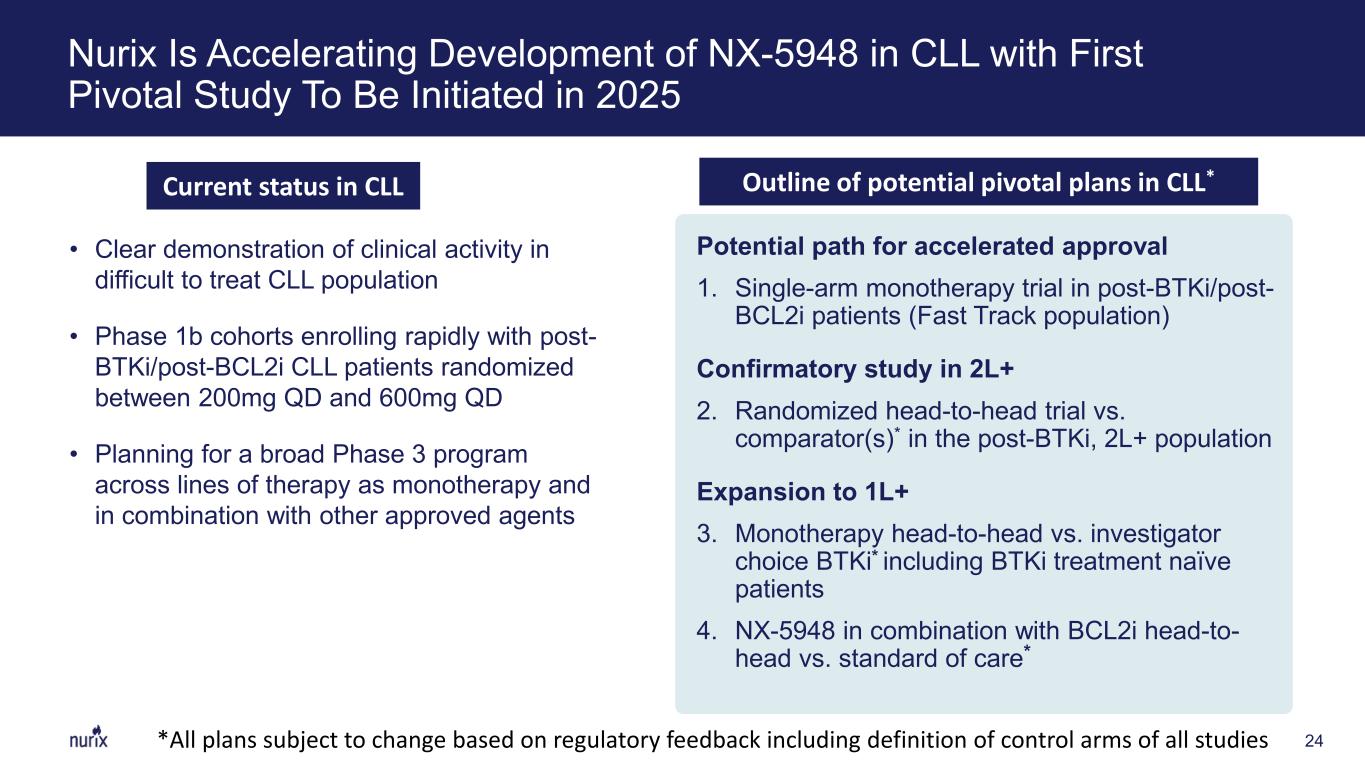
Nurix Is Accelerating Development of NX-5948 in CLL with First Pivotal Study To Be Initiated in 2025 • Clear demonstration of clinical activity in difficult to treat CLL population • Phase 1b cohorts enrolling rapidly with post- BTKi/post-BCL2i CLL patients randomized between 200mg QD and 600mg QD • Planning for a broad Phase 3 program across lines of therapy as monotherapy and in combination with other approved agents 24 Potential path for accelerated approval 1. Single-arm monotherapy trial in post-BTKi/post- BCL2i patients (Fast Track population) Confirmatory study in 2L+ 2. Randomized head-to-head trial vs. comparator(s)* in the post-BTKi, 2L+ population Expansion to 1L+ 3. Monotherapy head-to-head vs. investigator choice BTKi* including BTKi treatment naïve patients 4. NX-5948 in combination with BCL2i head-to- head vs. standard of care* Current status in CLL Outline of potential pivotal plans in CLL* *All plans subject to change based on regulatory feedback including definition of control arms of all studies

Section I: Q&A 25

NX-1607 and NX-2127 26 Clinical updates and next steps
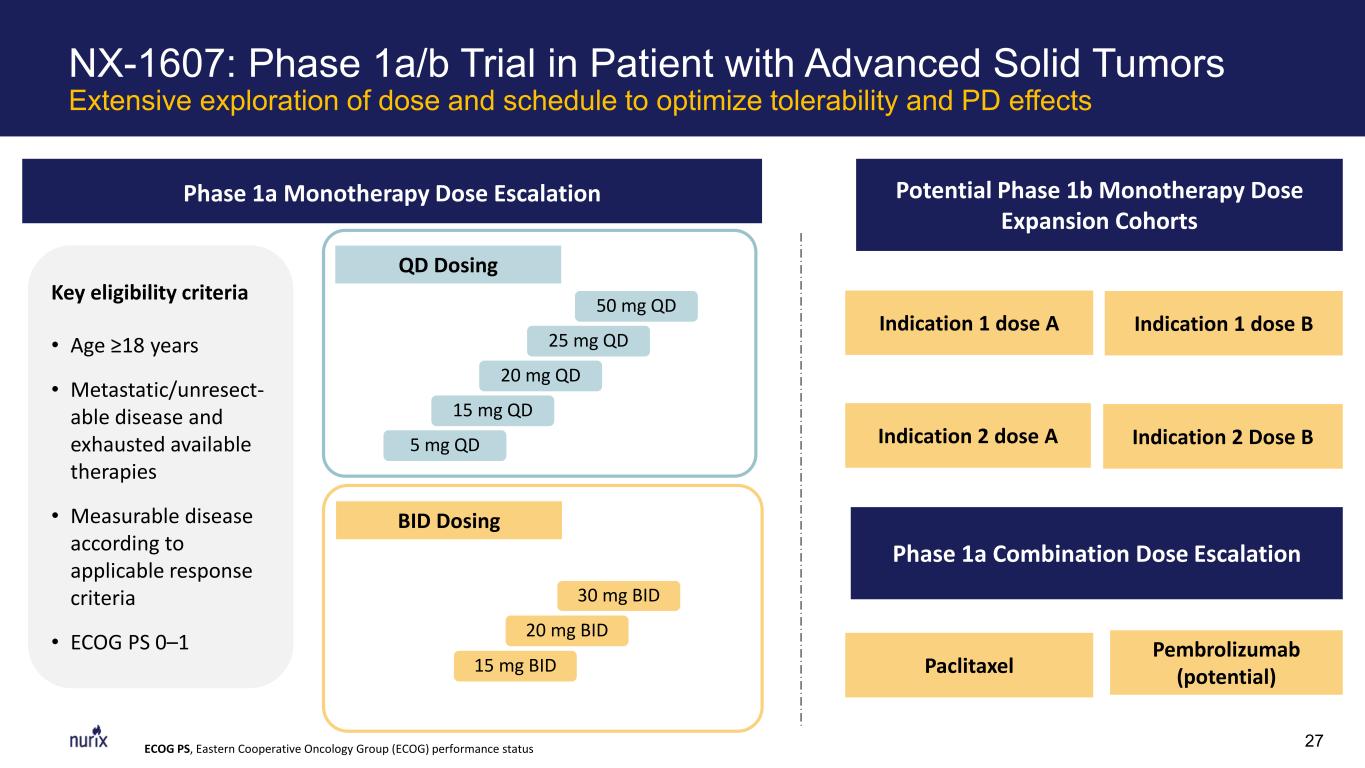
NX-1607: Phase 1a/b Trial in Patient with Advanced Solid Tumors Extensive exploration of dose and schedule to optimize tolerability and PD effects Phase 1a Monotherapy Dose Escalation Potential Phase 1b Monotherapy Dose Expansion Cohorts Key eligibility criteria • Age ≥18 years • Metastatic/unresect- able disease and exhausted available therapies • Measurable disease according to applicable response criteria • ECOG PS 0–1 15 mg BID 20 mg BID 30 mg BID BID Dosing Indication 1 dose A Indication 2 dose A Indication 2 Dose B Indication 1 dose B QD Dosing 5 mg QD 15 mg QD 20 mg QD 25 mg QD ECOG PS, Eastern Cooperative Oncology Group (ECOG) performance status Phase 1a Combination Dose Escalation Paclitaxel Pembrolizumab (potential) 50 mg QD 27
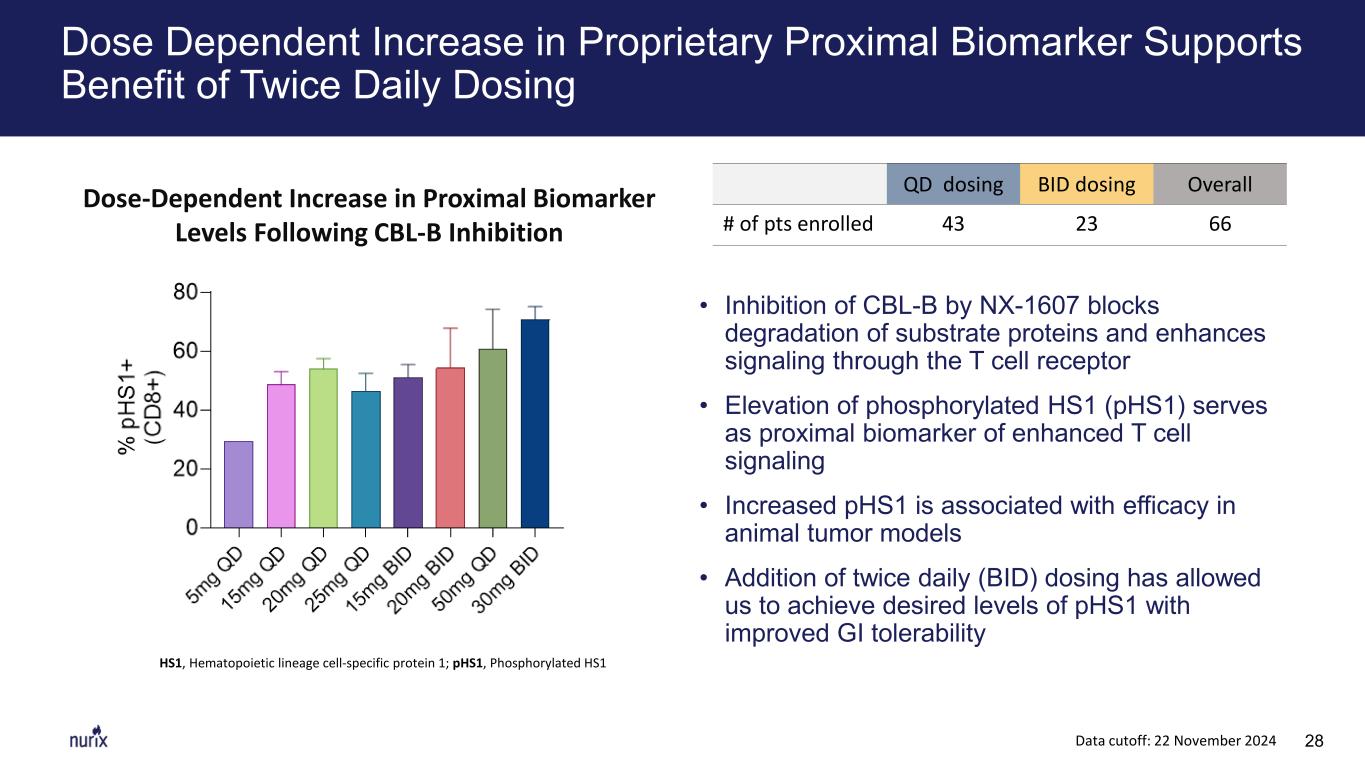
Dose Dependent Increase in Proprietary Proximal Biomarker Supports Benefit of Twice Daily Dosing Data cutoff: 22 November 2024 • Inhibition of CBL-B by NX-1607 blocks degradation of substrate proteins and enhances signaling through the T cell receptor • Elevation of phosphorylated HS1 (pHS1) serves as proximal biomarker of enhanced T cell signaling • Increased pHS1 is associated with efficacy in animal tumor models • Addition of twice daily (BID) dosing has allowed us to achieve desired levels of pHS1 with improved GI tolerability QD dosing BID dosing Overall # of pts enrolled 43 23 66 Dose-Dependent Increase in Proximal Biomarker Levels Following CBL-B Inhibition 28 HS1, Hematopoietic lineage cell-specific protein 1; pHS1, Phosphorylated HS1

29 NX-1607 Status and Next Steps Status • Phase 1a has enrolled 66 heavily pretreated patients across 11 different solid tumor indications • Oral dosing of NX-1607 has been associated with gastrointestinal tolerability issues that have been mitigated through exploration of ramp-up dosing, BID regimens, and anti-emetic prophylaxis • Drug exposures and proximal biomarker levels at the higher dose ranges are consistent with levels associated with anti-tumor activity in nonclinical models • Preliminary evidence of stable disease, tumor shrinkage, and biomarker and clinical responses have been observed Next Steps • Additional patients in the BID dosing arms are required to establish Phase 1b monotherapy dose • Additional clinical data will be shared after selection of a Phase 1b expansion dose(s) and indication(s)
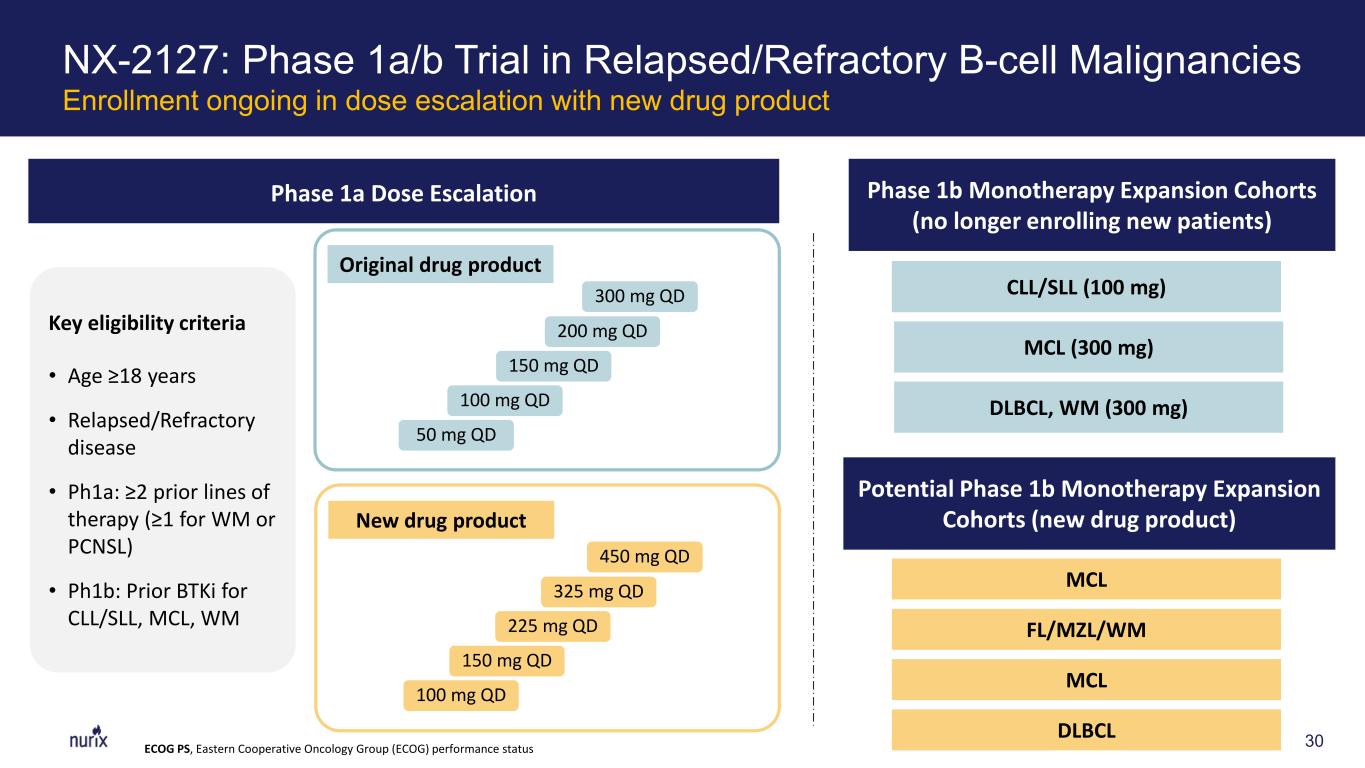
30 NX-2127: Phase 1a/b Trial in Relapsed/Refractory B-cell Malignancies Enrollment ongoing in dose escalation with new drug product Phase 1a Dose Escalation Phase 1b Monotherapy Expansion Cohorts (no longer enrolling new patients) Key eligibility criteria • Age ≥18 years • Relapsed/Refractory disease • Ph1a: ≥2 prior lines of therapy (≥1 for WM or PCNSL) • Ph1b: Prior BTKi for CLL/SLL, MCL, WM New drug product CLL/SLL (100 mg) DLBCL, WM (300 mg) MCL (300 mg) Original drug product 50 mg QD 100 mg QD 150 mg QD 200 mg QD ECOG PS, Eastern Cooperative Oncology Group (ECOG) performance status Potential Phase 1b Monotherapy Expansion Cohorts (new drug product) 300 mg QD 100 mg QD 150 mg QD 225 mg QD 325 mg QD 450 mg QD MCL FL/MZL/WM MCL DLBCL

Updated Clinical Case Study 1 Rapid and sustained complete response in WM transformed to DLBCL with NX-2127 Confirmatory Week 16 scan Deauville score: 2 Baseline FDG-PET CT Scan Disease Assessment Deauville score: 5 Bladder Bladder • 84-year-old female with WM diagnosed in 2003 with DLBCL (ABC subtype) transformation in 2015 – MYD88 and CXCR4 mutation • 4 prior lines of aggressive therapy – R-CHOP (CR) – R-ICE (PR) – Rituximab, mogamulizumab (anti-CCR4), magrolimab (anti-CD47) – Rituximab, ibrutinib, and lenalidomide • Complete response on first assessment at week 8, confirmed at week 16 • As of November 18, 2024, this patient remains in complete response and on treatment with 33 months of follow up (2.75 years) Case history 31Status update as of November 18, 2024
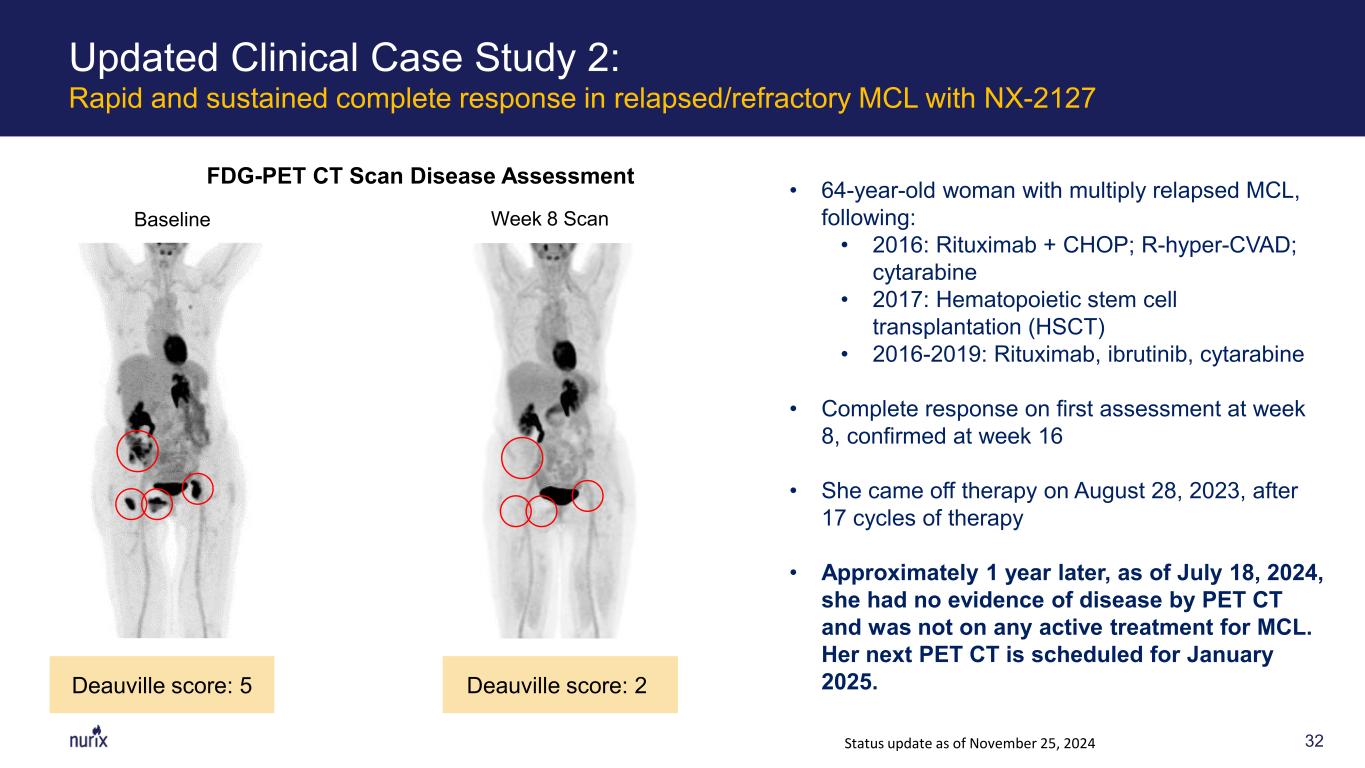
Updated Clinical Case Study 2: Rapid and sustained complete response in relapsed/refractory MCL with NX-2127 32 Week 8 Scan Deauville score: 2 Baseline FDG-PET CT Scan Disease Assessment Deauville score: 5 Bladder Bladder • 64-year-old woman with multiply relapsed MCL, following: • 2016: Rituximab + CHOP; R-hyper-CVAD; cytarabine • 2017: Hematopoietic stem cell transplantation (HSCT) • 2016-2019: Rituximab, ibrutinib, cytarabine • Complete response on first assessment at week 8, confirmed at week 16 • She came off therapy on August 28, 2023, after 17 cycles of therapy • Approximately 1 year later, as of July 18, 2024, she had no evidence of disease by PET CT and was not on any active treatment for MCL. Her next PET CT is scheduled for January 2025. Status update as of November 25, 2024

33 NX-2127 Status and Next Steps Status • We have re-initiated enrollment with the new, chirally controlled drug product • We are focused on the aggressive lymphomas for development of NX-2127 where the combination of BTK degradation and IKZF1/3 degradation have the potential for synergy and significant therapeutic benefit Next Steps • Complete dose escalation with new drug product and select recommended Phase 1b dose for selected indications • Additional clinical data will be shared after selection of a Phase 1b expansion dose(s) and indication(s)

NX-5948 in inflammation and immunology (I&I) 34 Rationale & strategy

Key Observations Underpinning Nurix’s NX-5948 Immunology and Inflammation Strategy The genetics of BTK are compelling: highly specific with potent biology • Human knockouts, originally described by Dr. Bruton in 1952, show agammaglobulinemia (no antibody production) and associated reduced immune function yet have otherwise normal physiology • Mouse xid mutants show a similar phenotype as the humans and solidly confirm the biology of BTK as a powerful B-cell drug target Positive clinical experience • BTK inhibitors have shown positive clinical results across a wide range of I&I diseases in hematology, dermatology, and neurology Inhibitors leave room for improvement • The same scaffolding functions that limit efficacy in oncology may also be limiting efficacy in autoimmune disease settings • Liver safety signals from BTK inhibitors may limit broad use 35 Multi-modal impact on inflammation

36 NX-5948 Is 10x to 100x More Potent in Blocking B Cell Activation than BTK Inhibitors Tested in I&I 0.001 0.01 0.1 1 10 100 1000 -75 -50 -25 0 25 50 75 100 125 Compound (nM) N or m al iz ed C D 69 NX-5948 Rilzabrutinib Remibrutinib Acalabrutinib Fenebrutinib Bead-Bound Anti-IgM Stimulation B Ce ll Ac tiv at io n Source: Noviski et al., ACR 2024, November 2024

• IL-8 is a chemokine that recruits neutrophils into inflamed tissues 37 NX-5948 Potently Suppresses Activation of Myeloid Cells Stimulated Through Key Inflammatory Receptors 0.001 0.01 0.1 1 10 100 1000 0.00 0.25 0.50 0.75 1.00 1.25 Compound (nM) IL -8 F ol d C ha ng e NX-5948 Rilzabrutinib Remibrutinib Acalabrutinib Fenebrutinib Plate-Bound IgG2 Stimulation 0.001 0.01 0.1 1 10 100 1000 0.00 0.25 0.50 0.75 1.00 1.25 Compound (nM) IL -8 F ol d C ha ng e NX-5948 Rilzabrutinib Remibrutinib Acalabrutinib Fenebrutinib IL-1β Stimulation Fc Receptor Pathway Inflammatory Signaling Pathway M on oc yt e Ac tiv at io n M on oc yt e Ac tiv at io n

NX-5948 Is Active Across a Range of Autoimmune and Inflammation Models 38 Systemic Lupus Erythematosus (MRL/Ipr Model) Lupus Nephritis (AIG Model) Multiple Sclerosis (EAE Model) Rheumatoid Arthritis (Established CIA Model) 10 12 14 16 18 20 0 1 2 3 Animal Age (Weeks) U rin e Pr ot ei n Sc or e M ea n ± SE M (0 -5 S co re ) Vehicle NX-5948, 30 mg/kg Ibrutinib, 30 mg/kg Dexamethasone, 2 mg/kg* * ** 10 15 20 0 1 2 3 Days After Immunization M ea n C lin ic al E AE Sc or e (0 to 5 ) ± S EM **** Vehicle NX-5948, 30 mg/kg Ibrutinib, 30 mg/kg FTY720, 3 mg/kg 0 2 4 6 8 10 M ea n ± SE M S um m ed S co re (M ax 2 5) -0% -100% -90% -92% -91% -81% Vehicle NX-5948 (30 mg/kg) Ibrutinib (30 mg/kg) Rilzabrutinib (30 mg/kg) Dexamethasone (2 mg/kg) Naive +Autoantibodies 0 5 10 15 0 1 2 3 4 Days M ea n Pa w S co re * *** **** NX-5948, 30 mg/kg Vehicle Rilzabrutinib, 30 mg/kg Enbrel, 10 mg/kg Tofacitinib, 30 mg/kg, BID Ibrutinib, 30 mg/kg **** Source: Noviski et al., ACR 2024, November 2024

NX-5948 Has The Right Clinical Profile To Address Unmet Clinical Needs in Both Oncology and I&I 39 Wide dose range produces robust BTK degradation Elimination of BTK’s scaffolding function Demonstrated ability to cross the blood-brain barrier Favorable safety profile in oncology clinical trials 0 2000 4000 6000 8000 10000 BTK degradation in all patients receiving NX-5948 BT K Pr ot ei n Le ve l (M FI , M ea n +/ - S EM ) Day 2 Day 15 Day 22 Day 29Day 8 50 mg 100 mg 200 mg 300 mg 450 mg 600 mg

NX-5948 I&I Vision: Introduce the First BTK Degrader with Practice Changing Potential Strategic considerations for introducing NX-5948 into immunology and inflammation: 1. Novel mechanism of action: First BTK degrader in I&I should be focused on areas where BTK has strong biologic rationale and an appropriate risk/benefit profile 2. Speed to proof of concept: Preference should be given to indications with potential for rapid proof of concept that could support additional indications requiring longer duration of therapy 3. Dosing and formulation: Expansion opportunities in I&I indications are significant and may require different dosages and/or formulation based on desired drug product profile and exposure 4. Medical marketplace: An oral BTK degrader could address multiple very large markets that should mesh with oncology pricing and reimbursement considerations 40 All of the above informed Nurix’s plan to introduce NX-5948 into I&I

Goal: Implement a sequenced, multi-organ system approach to generate the greatest opportunity for patients and value creation 1. Hematology: Leverage Nurix’s existing hematology expertise, seeking first proof of concept through study of CLL patients with secondary autoimmune-mediated hemolytic anemia with plans to explore non-malignant warm autoimmune hemolytic anemia (wAIHA) 2. Dermatology: Evaluate potential IND in hidradenitis suppurativa (HS); potential expansion in chronic spontaneous urticaria (CSU) 3. Neurology: Explore potential opportunity in multiple sclerosis (MS), given NX-5948’s CNS activity 41 Nurix’s Systematic Approach To Expand Development of NX-5948 Across Multiple I&I Indications

Next Steps: 1. Plan to open a new Phase 1b cohort for patients with CLL and associated autoimmune hemolytic anemia in H1 2025 2. Plan non-malignant hematology IND in 2025 for autoimmune cytopenias (e.g., wAIHA) 3. Conduct a healthy volunteer study of a new formulation to address potential need for broader range of doses and dose regimens for I&I indications (study underway) 4. Explore potential for additional indications in other organ systems based on evolving data (e.g., dermatology and neurology) 5. Provide additional information in 2025 on our broader I&I pipeline including the STAT6 (Nurix/Sanofi) and IRAK4 (Nurix/Gilead) programs 42 Implementing Nurix’s Systematic Approach to I&I

43 Nurix: Building Blocks of Success and Value Creation Drive NX-1607 and NX-2127 to proof-of-concept data Successfully execute NX-5948 development in CLL A core opportunity with Fast Track and Prime Designation, we are moving rapidly to pivotal trials in 2025 Advance our innovative degrader pipeline Developing a pipeline of novel oral degraders Pioneering the next gen technology of degrader antibody conjugates (DACs) Expanding our state-of-the-art platform to accelerated ligand and drug discovery Extend I&I opportunity with collaborators IRAK4 and STAT6 opt-in rights Expand NX-5948 as a pipeline in a product WM, NHL and I&I

Section II: Q&A 44











































